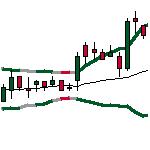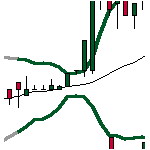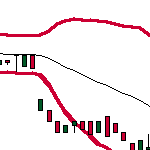iShares S&P/TSX Capped Energy Index ETF Forecast
Explanation to Bollinger's Bands
Bollinger Bands was created by John Bollinger in the early 1980s, its purpose is to define price action relative to the assets highs and lows. This technical indicator is used to identify buy and sell signals and has proven very well in doing so.
Bollinger Bands consist of a set of three curves drawn in relation to securities prices. The middle band is a measure of the intermediate-term trend, usually a simple moving average, that serves as the base for the upper and lower bands. The interval between the upper and lower bands and the middle band is determined by volatility, typically the standard deviation of the same data that were used for the average. StockInvest.us uses Bollingers suggested 20 day average.
Middle Bollinger Band = 20-period simple moving average
Upper Bollinger Band = Middle Bollinger Band + 2 * 20-period standard deviation
Lower Bollinger Band = Middle Bollinger Band - 2 * 20-period standard deviation
BandWidth defines the current width of the band.
%b defines the current position within the band.
BandWidth = (Upper Bollinger Band - Lower Bollinger Band) / Middle Bollinger Band
%b = (Last - Lower Bollinger Band) / (Upper Bollinger Band - Lower Bollinger Band)
Live Samples:



Bottlenecks in bandwidth indicate an upcoming change. Break up through the moving average line or continuous movements above the moving average line indicate a break up, and vice versa.
Source: http://www.bollingerbands.com
iShares S&P/TSX Capped Energy Index ETF downgraded to Hold/Accumulate
(Updated on May 09, 2024)
The iShares S&P/TSX Capped Energy Index ETF price gained 0.84% on the last trading day (Thursday, 9th May 2024), rising from $19.10 to $19.26. It has now gained 4 days in a row. It will be exciting to see whether it manages to continue gaining or take a minor break for the next few days. During the last trading day the ETF fluctuated 1.20% from a day low at $19.12 to a day high of $19.35. The price has risen in 7 of the last 10 days but is still down by -0.26% for this period. Volume fell on the last day by -210 thousand shares and in total, 474 thousand shares were bought and sold for approximately $9.12 million. You should take into consideration that falling volume on higher prices causes divergence and may be an early warning about possible changes over the next couple of days.
The ETF lies in the lower part of a wide and strong rising trend in the short term, and this may normally pose a very good buying opportunity. If the lower trend floor at $18.85 is broken, it will firstly indicate a slower rate of rising, but may also be an early warning for a trend shift. Given the current short-term trend, the ETF is expected to rise 22.23% during the next 3 months and, with a 90% probability hold a price between $23.04 and $25.79 at the end of this 3-month period.
Ready to grow your portfolio? Here's your beginner's guide to opening a free brokerage account.
XEG.TO Signals & Forecast
The iShares S&P/TSX Capped Energy Index ETF holds buy signals from both short and long-term Moving Averages giving a positive forecast for the stock, but the ETF has a general sell signal from the relation between the two signals where the long-term average is above the short-term average. On corrections down, there will be some support from the lines at $18.87 and $18.90. A breakdown below any of these levels will issue sell signals. Volume fell during the last trading day despite gaining prices. This causes a divergence between volume and price and it may be an early warning. The ETF should be watched closely. Some negative signals were issued as well, and these may have some influence on the near short-term development. A sell signal was issued from a pivot top point on Wednesday, April 10, 2024, and so far it has fallen -2.63%. Further fall is indicated until a new bottom pivot has been found. Furthermore, there is currently a sell signal from the 3 month Moving Average Convergence Divergence (MACD).
Support, Risk & Stop-loss for iShares S&P/TSX Capped Energy Index ETF
iShares S&P/TSX Capped Energy Index finds support from accumulated volume at $19.04 and this level may hold a buying opportunity as an upwards reaction can be expected when the support is being tested.
In general the ETF tends to have very controlled movements and with good liquidity the risk is considered very low in this stock. During the last day, the ETF moved $0.230 between high and low, or 1.20%. For the last week the ETF has had daily average volatility of 1.45%.
Our recommended stop-loss: $18.60 (-3.41%) (This ETF has low daily movements and this gives low risk. There is a sell signal from a pivot top found 21 days ago.)
Trading Expectations (XEG.TO) For The Upcoming Trading Day Of Friday 10th
For the upcoming trading day on Friday, 10th we expect iShares S&P/TSX Capped Energy Index ETF to open at $19.24, and during the day (based on 14 day Average True Range), to move between $18.94 and $19.58, which gives a possible trading interval of +/-$0.316 (+/-1.64%) up or down from last closing price. If iShares S&P/TSX Capped Energy Index ETF takes out the full calculated possible swing range there will be an estimated 3.28% move between the lowest and the highest trading price during the day.
Since the stock is closer to the resistance from accumulated volume at $19.31 (0.26%) than the support at $19.04 (1.14%), our systems don't find the trading risk/reward intra-day attractive and any bets should be held until the stock is closer to the support level.
Is iShares S&P/TSX Capped Energy Index ETF ETF A Buy?
iShares S&P/TSX Capped Energy Index holds several negative signals and this should be a sell candidate, but due to the general chance for a turnaround situation it should be considered as a hold candidate (hold or accumulate) in this position whilst awaiting further development. Due to some small weaknesses in the technical picture we have downgraded our analysis conclusion for this ETF since the last evaluation from a Strong Buy to a Hold/Accumulate candidate.
Current score: 0.629 Hold/Accumulate Downgraded
Predicted Opening Price for iShares S&P/TSX Capped Energy Index ETF of Friday, May 10, 2024
| Fair opening price May 10, 2024 | Current price |
|---|---|
| $19.24 ( 0.0865%) | $19.26 |
The predicted opening price is based on yesterday's movements between high, low, and closing price.
Trading levels for XEG.TO
Fibonacci Support & Resistance Levels
| Level | Price | |||
|---|---|---|---|---|
| Resistance | R3 | 19.47 | 1.11 % | |
| R2 | 19.39 | 0.651 % | ||
| R1 | 19.33 | 0.370 % | ||
| Current price: | 19.26 | |||
| Support | S1 | 19.16 | -0.543 % | |
| S2 | 19.10 | -0.82 % | ||
| S3 | 19.01 | -1.28 % |
Accumulated Volume Support & Resistance Levels
| Level | Price | |||
|---|---|---|---|---|
| Resistance | R3 | 19.39 | 0.675 % | |
| R2 | 19.35 | 0.467 % | ||
| R1 | 19.31 | 0.260 % | ||
| Current price | 19.26 | |||
| Support | S1 | 19.04 | -1.14% | |
| S2 | 18.86 | -2.08% | ||
| S3 | 15.84 | -17.76% |
XEG Dividend Payout History
| # | Ex-Date | Pay Date | Amount | Yield | |
|---|---|---|---|---|---|
| 1 | Mar 22, 2024 | Mar 22, 2024 | Mar 28, 2024 | $0.0930 | 0.507% |
| 2 | Dec 28, 2023 | Dec 28, 2023 | Dec 28, 2023 | $0.110 | 0.711% |
| 3 | Sep 25, 2023 | Sep 25, 2023 | Sep 25, 2023 | $0.233 | 1.38% |
| 4 | Jun 26, 2023 | Jun 26, 2023 | Jun 26, 2023 | $0.150 | 1.06% |
| 5 | Mar 22, 2023 | Mar 22, 2023 | Mar 22, 2023 | $0.167 | 1.17% |
FAQ
Click here for our free guide on how to buy iShares S&P/TSX Capped Energy Index ETF ETF.
